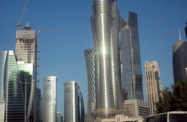For many months now, investors worldwide have been putting US Federal Reserve Chair Janet Yellen’s every statement under the strongest of analytical microscopes.
A global search amongst her words for signs and portents regarding the future of interest rates has long been under way – with July’s meeting of the Federal Open Market Committee (FOMC) prompting yet another round of speculation.
Yet, while there is still much contention over the exact timing and scale of any rate rise, most investors are agreed that before the year is out, US rates will get their first major hike in almost a decade.
This has major implications across the global economy, with the countries of the Gulf Cooperation Council (GCC) – including Qatar – unlikely to be immune from the impact. With the state’s currency pegged to the dollar, rate rises posted in Washington will likely mean rate rises in Doha.
How these will play out as Qatar looks to maintain growth and spending in an environment of falling oil and gas prices – and therefore state revenues – is a major question for the country’s planners and businesses.
Ups and Downs
If the US does raise rates later this year – and some analysts suggest this could come as early as September – emerging markets (EMs) are thought particularly likely to suffer. Raised rates will make the US even more of a preferred destination for investors than it already is, boosting capital outflows from EMs.
A recent report from QNB though, suggests that some EMs will be better protected in this eventuality than others.
Those with large current account deficits that need significant capital inflows to finance will be particularly vulnerable. Another source of concern will be countries with large external debts, as these too are often held in dollars. As the greenback strengthens, servicing these debts will become increasingly onerous.
Fortunately, Qatar is in a strong position regarding these two major potential problem areas. The country has been running a current account surplus for many years – although the size of this has been shrinking in recent times, as oil and gas prices have fallen. Indeed, it may potentially shrink further as Iranian oil and gas enters the market, should the current nuclear deal go through.
Regarding external debt, this is also relatively low in Qatar – the IMF put net government external debt at around 9% of GDP in 2014. This contrasts with countries of more concern, such as Turkey and South Africa, with external debt levels of 50% and 41% of GDP respectively.
What has been exercising minds in Doha more then, is the potential impact of a strengthening dollar and higher US rates on the Qatari riyal, local bond yields – which have already been rising – and interest rates.
The dollar peg means Doha is obliged to follow the US when it raises or lowers its rates. The question thus becomes, while it may make sense for the Fed to raise rates this year, does it make sense for Qatar – and other GCC countries – to do likewise?
A first glance at the economic indicators suggests not. Lower oil prices have impacted the economy, and while those prices stabilised around $65 a barrel in the earlier part of the year, they have since fallen again, with Brent crude trading at around $53 at the end of July. The government also cut its GDP growth forecast for 2015, while the IMF expects a gradual slowing in real GDP growth over the next few years, as public investment tapers off.
While the Fed is likely to raise interest rates on the back of accelerating growth in the US economy, encouraging extra growth is more of a concern in the Gulf.
This concern was behind a personal opinion from the Qatar Central Bank’s Director of Research and Monetary Policy, Khalid Alkhater, who said back in January that a Fed rate hike would come “at the wrong time” for the GCC.
This illustrated what he saw as a growing tendency for the US and Gulf economies to be out of sync. This echoed arguments made back in 2008, when the global financial crisis hit. Back then, the US was slashing interest rates to stem the meltdown, while Gulf economies continued to boom.
Yet for all this dissonance, the currency peg still has its advantages, as does a stronger dollar. The latter has had a deflationary effect within Qatar, while also strengthening the purchasing power of revenue from dollar-priced exports, such as oil and gas.
On the peg itself, the IMF remains in favour, reporting back in April that the peg has served Qatar well, both when oil and gas prices have been high and when they have been low.
According to the IMF, the peg anchors prices and provides stability to income flows and financial wealth. It further stated that while there are disadvantages to the restrictions on monetary policy a peg creates, in Qatar, fiscal and macro-prudential policies can handle anything these restrictions throw up.
Doha does also have some time to play with, as its rates are already higher than US ones – the QCB deposit rate has been steady at 0.75% since 2011, while the US Fed funds rate has been around 0.25%.
July’s FOMC meeting saw the US decide to keep rates unchanged for now, but Qatar will likely have to respond to a rise soon. Many investors will thus be waiting to see just how in or out of sync that response is obliged to be.
---This original article from OBG originally appeared in Qatar's The Edge magazine, August 2015 issue.

